




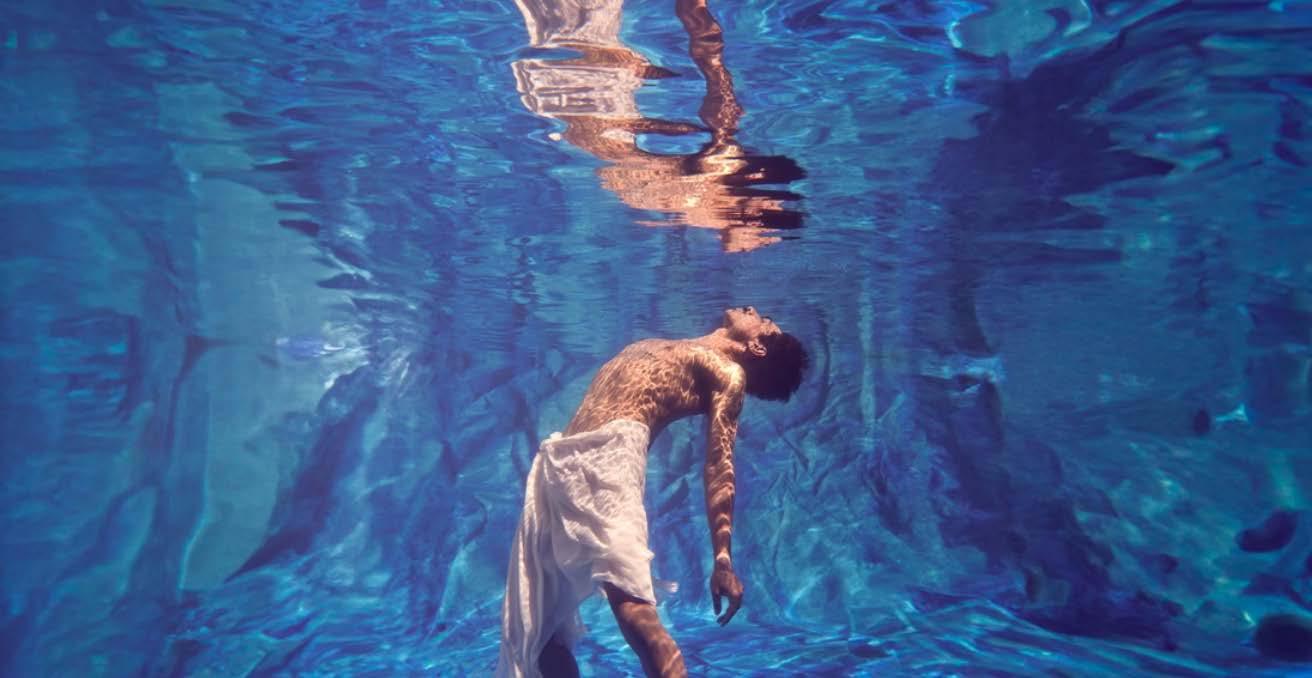
World-renowned, and a leader in Australian performing arts, Bangarra Dance Theatre returns to Wollongong after a long absence, with their highly acclaimed collaborative work: The Light Inside.
Bangarra’s first mainstage cross-cultural collaboration sees leading Māori choreographer and Arts Laureate, Moss Te Ururangi
Patterson, join forces with beloved Bangarra alumna and proud descendent of the Wakaid Clan and Meriam people of the Torres Strait, Deborah Brown. Together they guide Bangarra’s award-winning ensemble in stories that honour their mother countries and the spirit that calls them home. Book tickets via the Merrigong Theatre Co’s website
By Melissa Ritchie, president of IAVA
The Illawarra Association for the Visual Arts (IAVA) is excited to present Crossing Paths, an exhibition celebrating the vibrant work of 25 talented local artists. This exceptional collection will be on display at The White Cottage Gallery, set in the historic Retford Park, Bowral, from 20 February to 23 March.
A special opening event will take place on Saturday, 22 February from 2-4pm, offering a chance for guests to meet the artists, discuss their works, and enjoy drinks amidst the beauty of Retford Park.
The exhibition will feature a diverse range of contemporary artworks by IAVA members, including painting, sculpture, photography, and mixed media. Each work explores the unique perspectives of the artists, offering a window into the creative
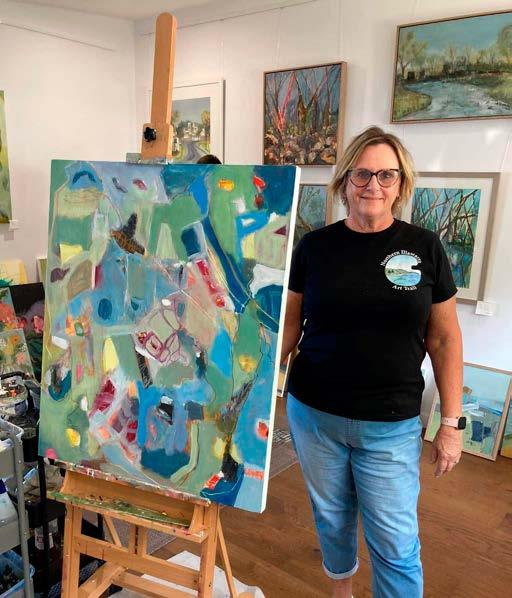
spirit of the Illawarra region. Pictured above is IAVA’s Gail Etheredge in her art studio. Check our free community calendar for more info.
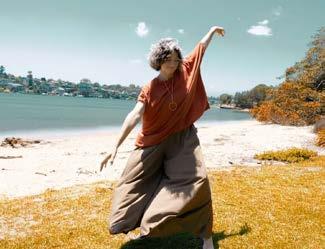

By Tyneesha Williams
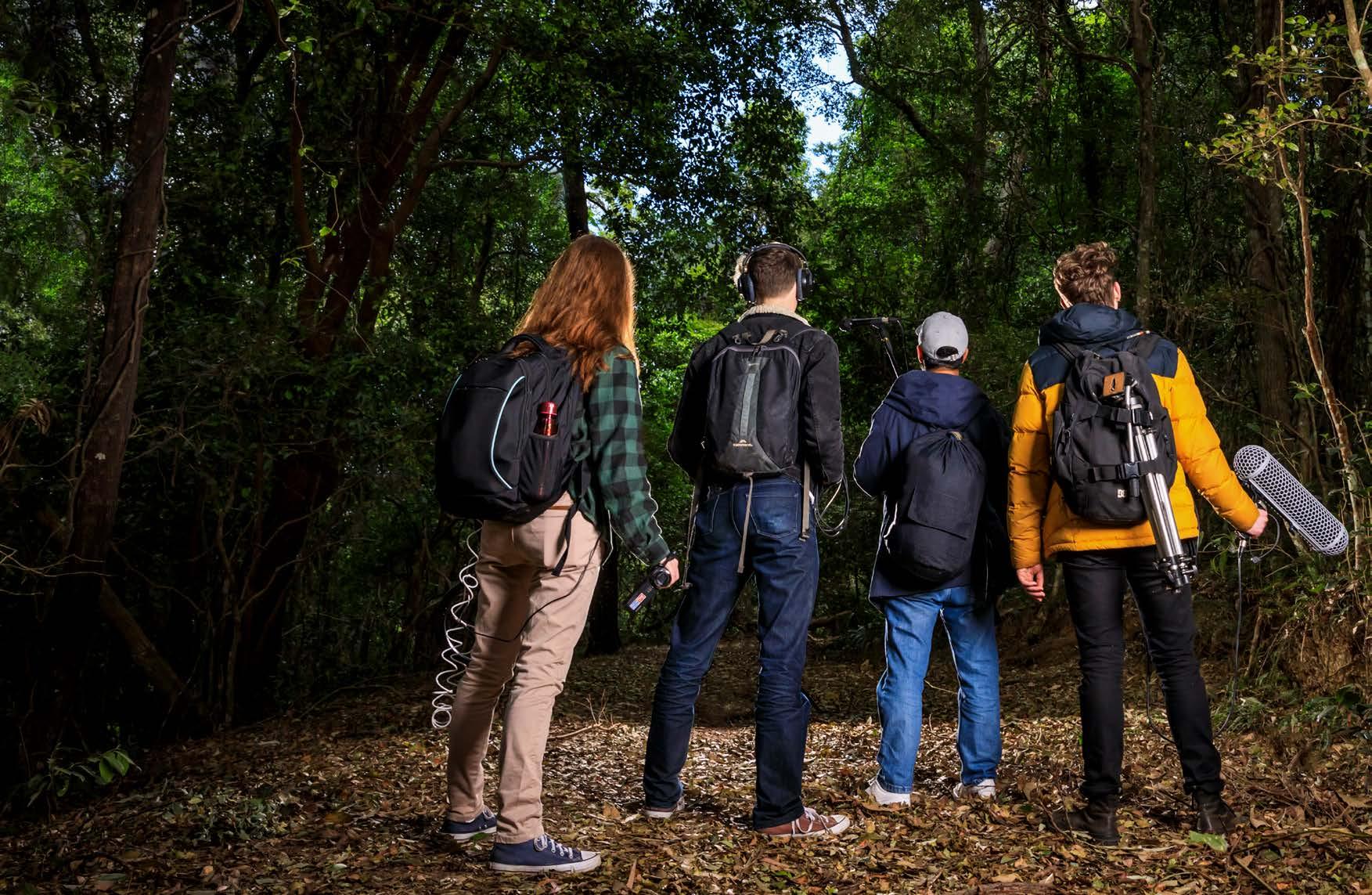
Merrigong Theatre Company has announced its 2025 MerrigongX artists’ program and audiences can expect the unexpected.
“You don’t always know what you’re going to get when you see a MerrigongX show,” says Annie Clapton, the company’s producer of new work.
“These shows are all experimental in very different ways. They’re all playing with form – but they’re all unexpected theatre pieces which makes it a really engaging experience for audiences.”
In its eighth year, the program will showcase four local productions, support 14 developing artists and host three Made from Scratch nights.
“Our artists are the whole focus. MerrigongX is about helping them
develop new work and their creative practice,” Annie says.
“We like working with artists who are going to try something new and challenging, and play with form a bit – experiment with things that aren’t necessarily traditional theatre.”
The four shows to be staged at IPAC – Public Access, Squatch Watch: LIVE, Yandha Djanbay (Go Slowly) and Dog People – have been developed over the past three years by artists in the MerrigongX program.
“I think shows can be rushed to the stage sometimes, but we want to give artists the time to develop their practice and bring it to audiences in their own time,” Annie says.
“I think it produces a really high
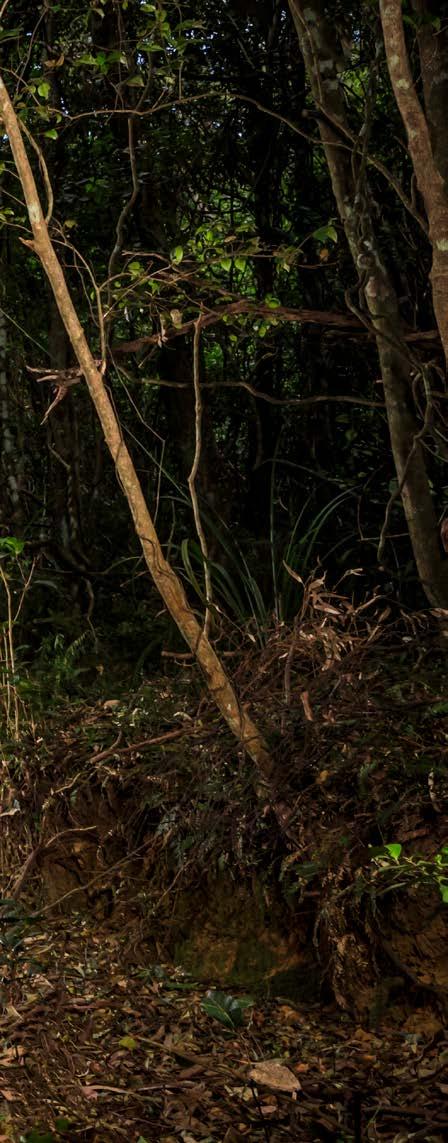
“You don’t always know what you’re going to get when you see a MerrigongX show. These shows are all experimental in very different ways.”
– Annie Clapton, Merrigong’s producer of new work
quality of work when we are able to let artists do that.”
Acclaimed Gunai artist Kirli Saunders will kick off the program with Yandha Djanbay (Go Slowly) shows starting on Thursday, February 20.
“Kirli has been working with us since 2020,” Annie says.
“Previously she was developing a show called Going Home. She was trying to make that in a traditional theatre structure, and in recent years it has evolved beyond that,
“The show now covers all of the different art forms that she works in – it has music, it has poetry, it has dance and it’s become a very non-traditional structure.
“It’s also the first First Nations work within MerrigongX, which we are very happy to finally get out on stage.”
Lucy Heffernan’s Dog People will show in June. Her previous 2018 MerrigongX show, Party Girl, won Adelaide Fringe Weekly Award for Best Theatre in 2023 and went to 2024’s Edinburgh Fringe Festival.
“It’s sort of a love story to dogs and dog people,” Annie says.
“Through investigating and developing that work, it’s also become about grief and how people are like their dogs – and dogs are like your family and how often we can learn a lot about grief through our pets.
“It involves a hilarious and slightly sinister dog mask, which one of the performers wears. I love that mask.”
Squatch Watch: LIVE by Vaguely Adjacent will take to the stage in September. Annie says this show is an example of how experimental MerrigongX artists can be.
“It is officially a live podcast event, but it’s actually made by four theatre majors,” Annie says.
“The podcast format is an interesting device they’ve used to comedically investigate different conspiracy theories and hoaxes. They’ve chosen an interesting way to look at that idea.”
In October, The Corinthian Food Store will present Public Access, an immersive exploration of public spaces shown in Wollongong Library.
“It’s a really interesting show about how to interact in public spaces in a world that’s heading more towards privatisation,” Annie says.
“We made sure to have it performed in the public library. Instead of recreating a library on stage, they wanted to bring people into libraries and have that energy, and make it more of an interactive piece,
“So that’s quite an innovative way of investigating public spaces. Wollongong Council have been excellent to work with in figuring out how to do that.”
MerrigongX opens applications once a year from August to September for a four-week period. MerrigongX will host three Made from Scratch events this year – in March, June and September. Made from Scratch gives applicants the chance to test new ideas to a new audience.

Dog People and Squatch Watch: LIVE will be on later this year. Photos supplied
By Local Studies Senior Library Service Officer Lisa Hutton

“With Windang Beach on one side and Lake Illawarra on the other with the stunning Illawarra escarpment as a backdrop it was not long before holiday makers flocked to the campground.”
– Lisa Hutton

Summer holidays spent at a caravan park with long days in the sun, swimming, fishing, riding bikes and enjoying the freedom of school holidays brings back fond memories for many Illawarra families.
In the 1950s and 1960s, Windang was one of the popular destinations that families would flock to, turning a tiny caravan or small family tent into home for a few days – or a few weeks over summer. Windang offered the added attraction of Lake Illawarra where families could add prawning to the list of summer holiday activities.
Windang is said to have been ‘founded’ by William Turnbull who purchased land near the waterfront and surrounds in 1920 and erected a two-story building called ‘Wyndang House’. In 1926 the Post Office attached to the house was re-named Windang Post Office – an Aboriginal word meaning “scene of a fight.”
Believing it would be wise to hold some land “in perpetuity” for the public, Turnbull suggested that Council acquire land at the mouth of Lake Illawarra and proclaim the area a reserve. “Thus for all time, a beautiful spot on the seafront at the mouth of Lake Illawarra is there for the people,” Turnbull recalled in 1988.
To support lake fishing and prawning,
Windang Reserve Caravan Park 1960.
Photo: P43955 from the Collections of Wollongong City Libraries
Ben Howard built the Windang boat shed in 1936 and along with his wife Mary, opened a shop with a fresh seafood restaurant attached.
In June 1949 the South Coast Times and Wollongong Argus reported that the City Council had decided to establish its first caravan camping area as caravan camping was becoming increasingly popular.
Council decided to allocate a “suitable site for a caravan parking area at the Windang camping reserve.” It was also decided to erect power posts in the area to provide electricity for 12 caravans at a cost of forty pounds.
With Windang Beach on one side and Lake Illawarra on the other with the stunning Illawarra escarpment as a backdrop it was not long before holiday makers flocked to the campground for an affordable holiday by the beach and lake.
Each summer a Carnival would set up next to the lake providing nighttime entertainment for the tourists in the caravan park and locals alike. Rides, sideshow alley, bright lights, music and fairy floss and popcorn finishing off the perfect summer holiday.
You can find many interesting stories and photos in Wollongong City Libraries online catalogue.
Email: localhistory@wollongong.nsw. gov.au

Steel City Strings is collaborating with community gamelan ensemble Suwitra Jaya for part of this concert inspired by folk music traditions from around the world including Australian composers Peter Sculthorpe, Gerard Brophy and Christopher Sainsbury.
Bowral Memorial Hall, Sun 9 March 2.00pm
Wollongong Art Gallery, Sat 15 March 7.30pm Berry School of Arts, Sun 15 March 2.00pm
For bookings scan the QR code or go to: steelcitystrings.com.au/events-calendar/

Tickets $15 – $65 Group of 5 or more $40 per person

Renovated and well-equipped meeting rooms and office space in the village centre. Enquire now for availability.
26A Walker St, Helensburgh Phone 02 4227 8181 wollongong.nsw.gov.au/centres

By Amanda De George
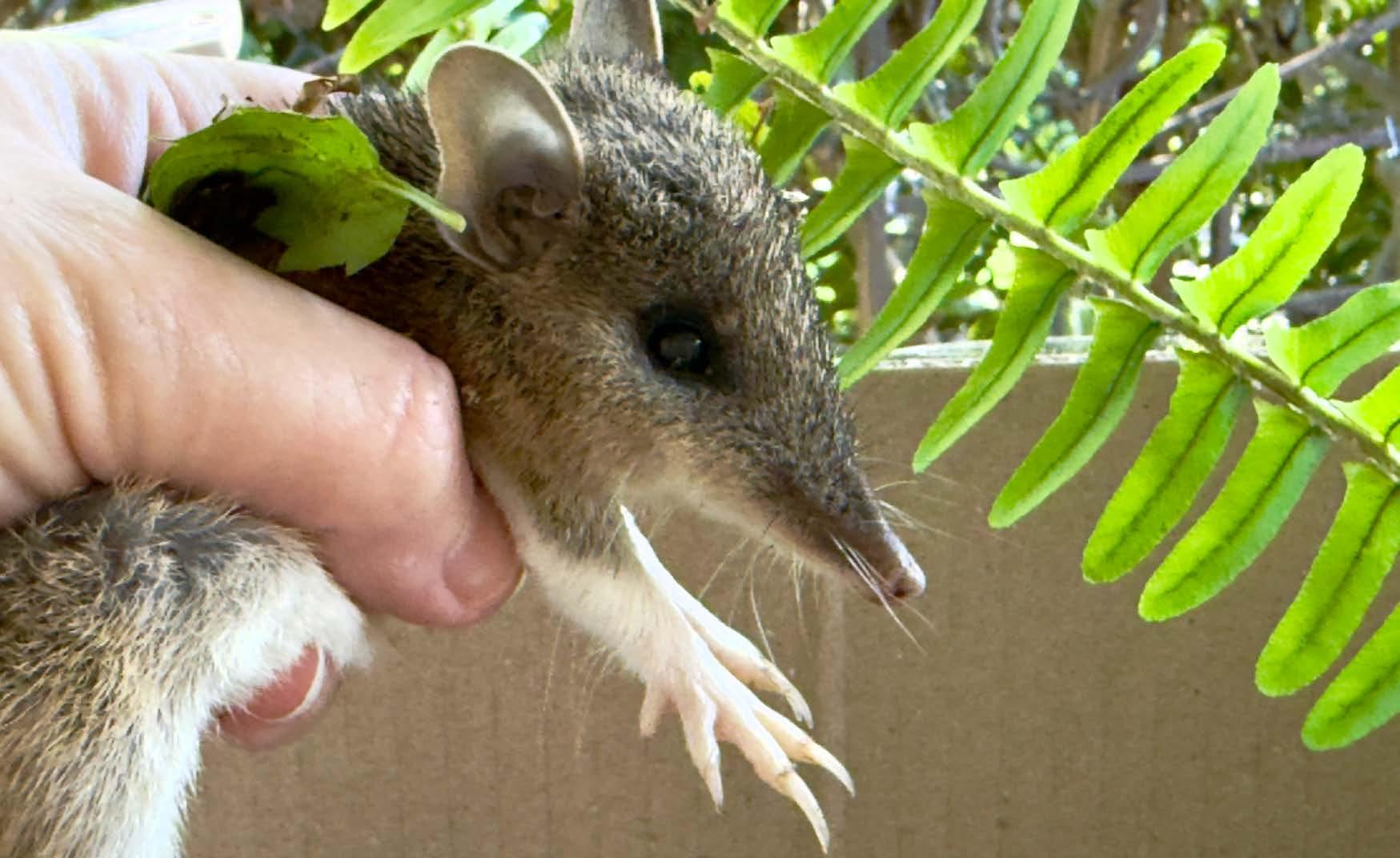
There’s no way around it, when we live with nature, we affect nature and it affects us.
It’s in the front of my mind when trimming back plants around our yard. Tiny crab spiders launch themselves on silken ropes, and plant hoppers leap skyward just as I’m about to put the cuttings in the green waste bin. Oops, close call for them and I carefully pop them back in the garden. And I’m guilty of leaving huge sheets of cobwebs adorning our eaves and windows, worried for the spiders who call it home and the wattlebirds that swoop in, who call the spiders ‘dinner’.
But the concept of human impact was really brought home this week, as we finally started to replace our very old, wooden paling fence. As the fence has
started to rot and lean, I’ve let the vines and ferns take over. They snake up the wood, holding it all together and the dense tangle of greenery has provided shelter and safety to countless animals. And the fishbone ferns multiplying at its base have provided home to bandicoots. Bandicoots are often mistaken for rats and that’s actually what happened as the tradies, knee deep in vegetation, shrieked as what they thought was a rat hopped out of the bracken they were noisily removing.
Long-nosed bandicoots are nocturnal and spend the day curled up in logs or in shallow holes in the ground, lined with grasses and other foliage. You might have spotted finger-deep holes in your garden where the bandis stick their long snouts, sniffing out, well, pretty much

everything. They happily feast on insects, lawn grubs, fruits, roots, underground bulbs, cockroaches, mice and even dog food left outside.
The one that was hoisted aloft by the tradies was only young and I quickly scooped it up and gave it the once over. Bandicoots are on their own from around 60 days old and this one was definitely independent.
It was no use releasing her straight away with the work ongoing so I grabbed a box, lined it with leaf litter and ferns, made some ventilation holes and left her in the shade on our porch. Now to tell you the next bit I have to reveal that I did peak in the box once or twice (okay, three or four times) but it was really lovely to see her curled up and snoozing away after what must have been a scary
morning.
As night fell, I put the box on its side next to a similarly undergrowth-dense spot in my yard. I watched as she turned her snout up at the new spot and went in search of her ferny home… which was unfortunately no longer there.
While a lot of the greenery has to go to physically remove the fence, we decided that we’d leave a fair chunk of the masses of fishbone fern in place to give the bandis (and their friends) somewhere to shelter until we can establish a new habitat alongside the new fence. After all, our home is their home and we’re keen for them to stay.
To learn how to make a bandicoot bungalow and what to plant to attract these nocturnal marsupials to your yard, head here
“Bandicoots are often mistaken for rats and that’s actually what happened as the tradies, knee deep in vegetation, shrieked”
– Amanda De George
By Nicky Nicky Sloan, CEO of Community Industry Group

“On
a typical day up to 150 public hospital beds in the Illawarra Shoalhaven Local Health District (ISLHD) are occupied by patients who no longer need hospital care, but are unable to return home.”
– Nicky Sloan
Community Industry Group (CI Group) have been aware for more than five years that hospital beds ‘blocked’ by older patients approved for aged care was an issue, but we were all shocked when two years ago heard that Illawarra/Shoalhaven had the worst bed block in the country.
On a typical day up to 150 public hospital beds in the Illawarra Shoalhaven Local Health District (ISLHD) are occupied by patients who no longer need hospital care, but are unable to return home. This is variously called Bed Block or Delayed Discharge and it’s a social justice issue, where older people can’t get the full-time appropriate care they need at a very vulnerable point in their lives.
Hospitals are amazing places when you are unwell, and the staff are exceptional. But they are not places to live your life. While most people stay in hospital for an average of four days, the average stay for an older person in this situation is 66 days – and, for many, it’s much, much longer. Most of these people will eventually be discharged to a residential aged care home, but the region has a chronic shortage of these vital aged care places.
So, we started to look into it, and found that, despite the obvious demand – and indeed growing demand – the number of aged care beds across the region has not increased in close to a decade. The Illawarra Shoalhaven region
has a current aged care deficit of 1,025 beds. While some new places have opened, an equivalent number have closed for a range of reasons, including:
• ageing buildings which don’t meet new accreditation standards,
• closure of multi-bed rooms to meet new quality standards and customer demands,
• repurposing of inappropriate stock for community needs,
As well as governance, financing, staffing and planning obstacles during arguably aged care’s most difficult era.
Exacerbating the issue is the fact that we are also desperately short of Home Care Packages to support older people to live well in their own homes. Current estimates are that we are short 1,024 home care packages across the region. It is no wonder that older people are ending up in hospital.
Now we can’t place the blame at the feet of aged care providers. Aged care is now a free market system, and here it is a market that has failed to meet the needs of local people. The very fact that demand well exceeds supply, but still providers are not able to develop aged care in our region, tells us that.
For the past year, CI Group has been leading projects to address bed block and support older people who are unable to leave hospital, and their families, including the fabulous STARS volunteer transition support services.


By Emma Rooksby, coordinator of Growing Illawarra Natives
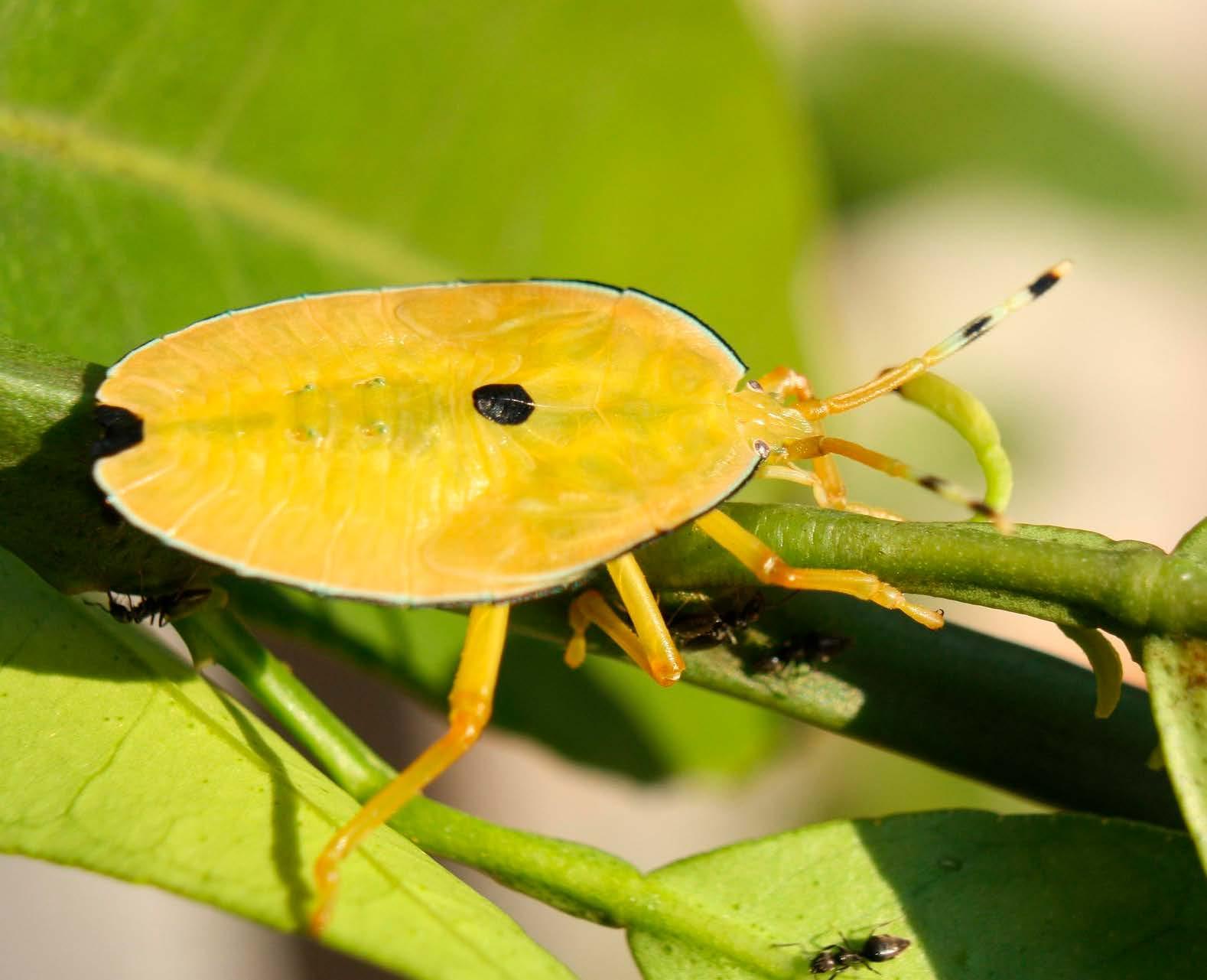
A Bronze Orange Bug in an earlydevelopmental stage. Later instars are larger and more brightly orange-coloured, while the fully grown bugs are black and winged. Image by MrsKirk72 at Pixabay.
Social media is lighting up in 2025 with images of all kinds of insect: native bees, bugs, beetles, flies, wasps and many more. Invertebrate biodiversity really seems to be having a moment.
READ MORE
Beetles v Bugs by Dr
Chris Reid
I normally use this column to write about plants, but am switching things up a bit this week to cover some of these critters that interact with Illawarra’s local native plants, namely stink bugs! (And I promise, there’s a direct link with the article about Swamp Hibiscus I posted last week.)
Pretty well everyone who has a citrus tree in a pot or in the garden is familiar with the Bronze Orange Bug (Musgraveia sulciventris). This sap-sucking bug is
native to coastal eastern Australia, where it has evolved with native citrus species such as the Finger Lime (Citrus australasica). It is generally reviled for its ability to damage native and exotic citrus plants, plus its habit of spraying out a foul-smelling liquid when threatened, and the internet is overflowing with strategies for killing it. But! We have other local bugs that aren’t such a pest, and that are sometimes confused with the Bronze Orange Bug. The Growing Illawarra Natives discussion group recently had such an incident when a concerned resident shared images of an Illawarra Flame Tree (Brachychiton acerifolius) with a number
of orange bugs visible on its ripening seed pods.
But on closer inspection, these bugs turned out to be a different species.
They were actually Hibiscus Harlequin Bugs (Tectocoris diophthalmus), another species of sap-sucking insect that likes to hang out on plants in the mallow (Malvaceae) family. The Malvaceae family includes Hibiscus species (told you there was a link to last week’s piece!) and also Brachychiton species including the Illawarra Flame Tree.
They are not much of a pest, though, and rarely do major damage to the plants they’re on.
If you look closely at the picture you can see some orange individuals (these are adult females) with a few metallic blue patches on their back (technically their scutellum), plus some smaller red and blue numbers, which are actually all the same species.
Female and male adult Hibiscus Harlequin Bugs look different (the males are more red and blue), while the earlier developmental stages (or instars) are different again. The picture below right shows some bugs at an earlier instar.
But back to the Bronze Orange Bugs to finish!
If you’ve got them at your place or have seen them around, don’t write them off as just a pest to eliminate; you can engage in a little citizen science. This species is followed by Climate Watch, an initiative by the EarthWatch Institute, the University of Melbourne and the Australian Bureau of Meteorology to understand how changes in temperature and rainfall affect seasonal behaviour of plants and animals. Its presence is tracked here.
Below left: These bugs on an Illawarra Flame Tree (Brachychiton acerifolius) were recently photographed by an Illawarra resident, concerned that they were Bronze Orange Bugs damaging the tree. Image by Kelly Jones.
Below right: A group of young Hibiscus Harlequin Bugs (Tectocoris diophthalmus) just hanging out on a leaf of a Native Hibiscus (H. heterophyllus), not doing any major harm. Image by Emma Rooksby
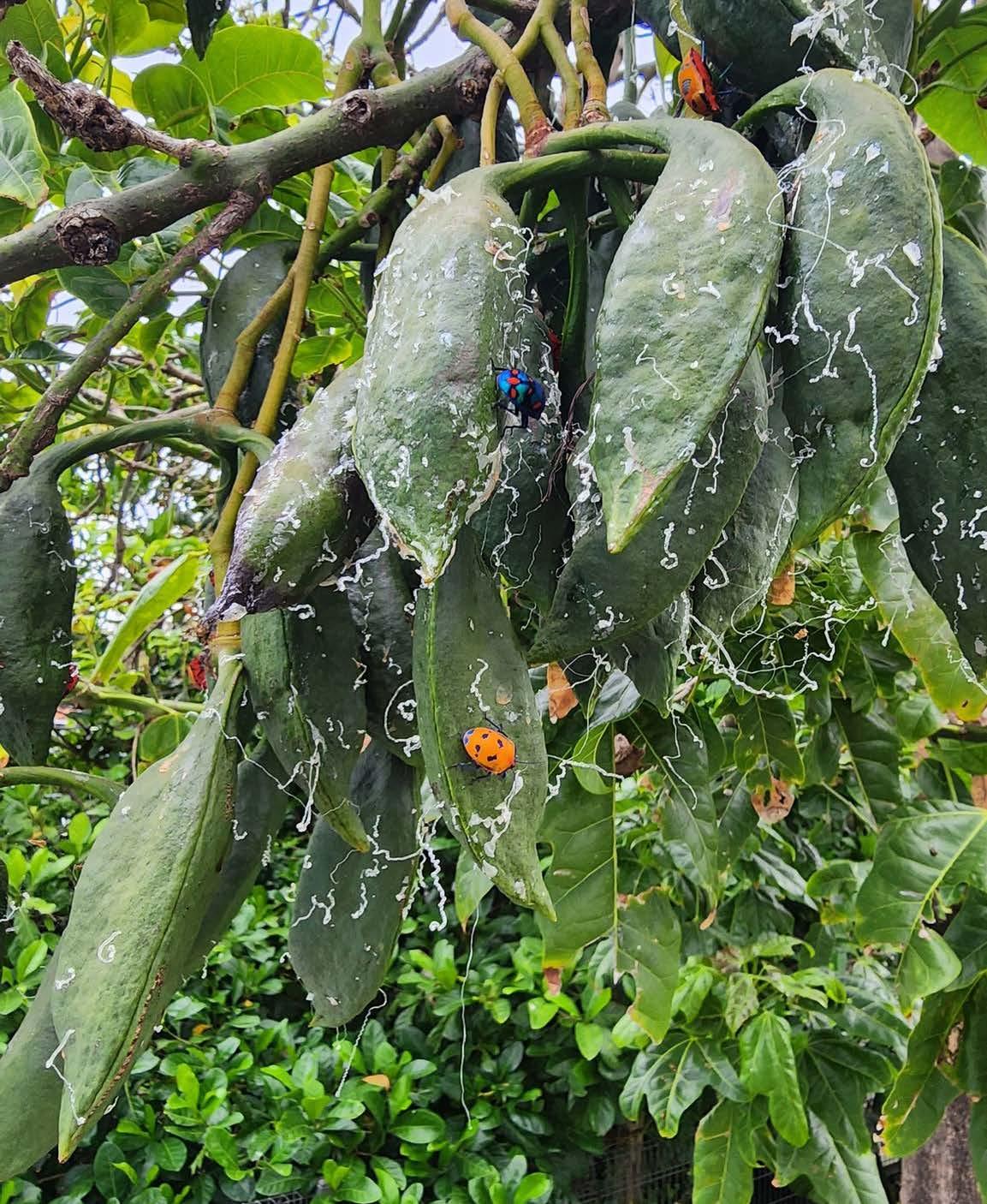
“They were actually Hibiscus Harlequin Bugs, another species of sap-sucking insect that likes to hang out on plants in the mallow (Malvaceae) family”
–
Emma Rooksby

The awards were held at City Beach Function Centre on Thursday, Feburary 6.
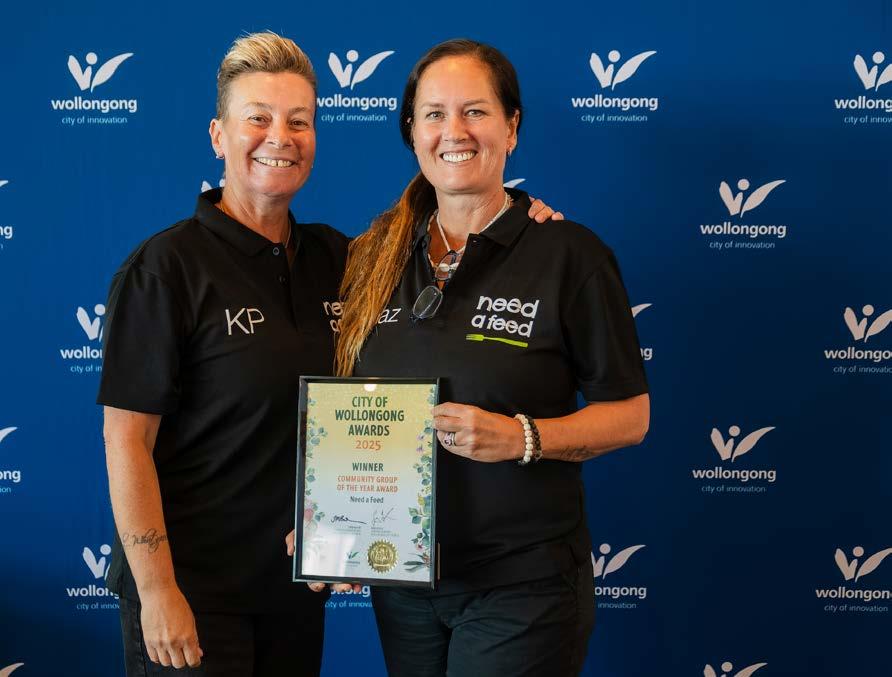

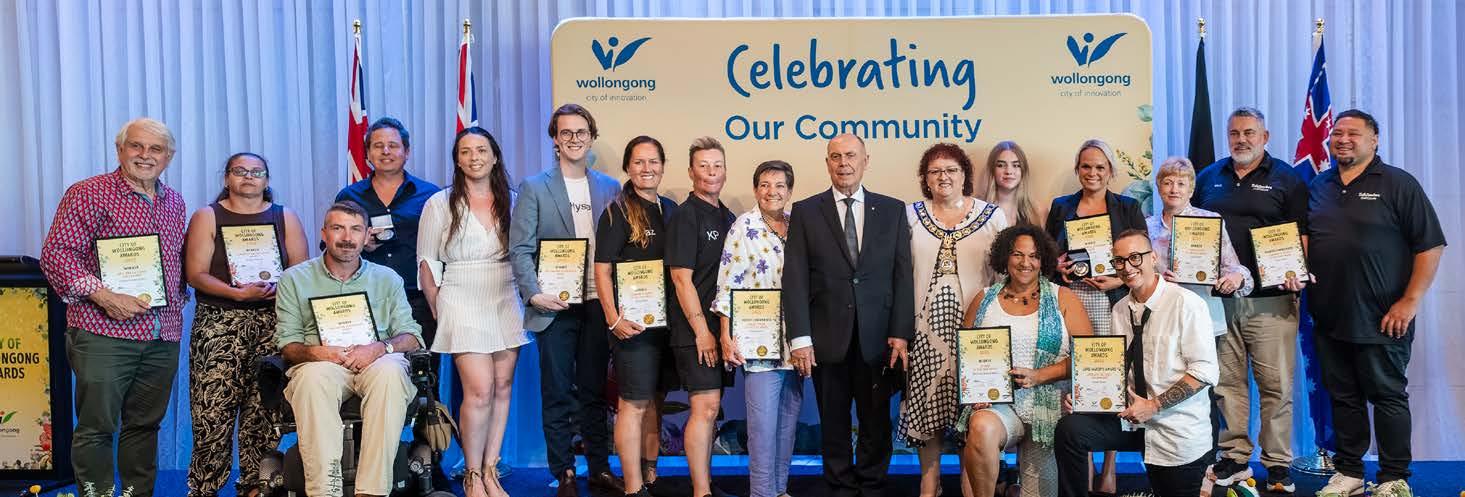


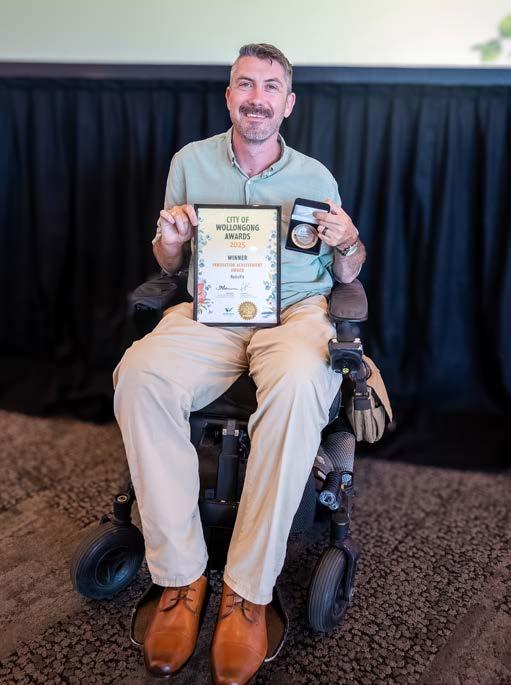


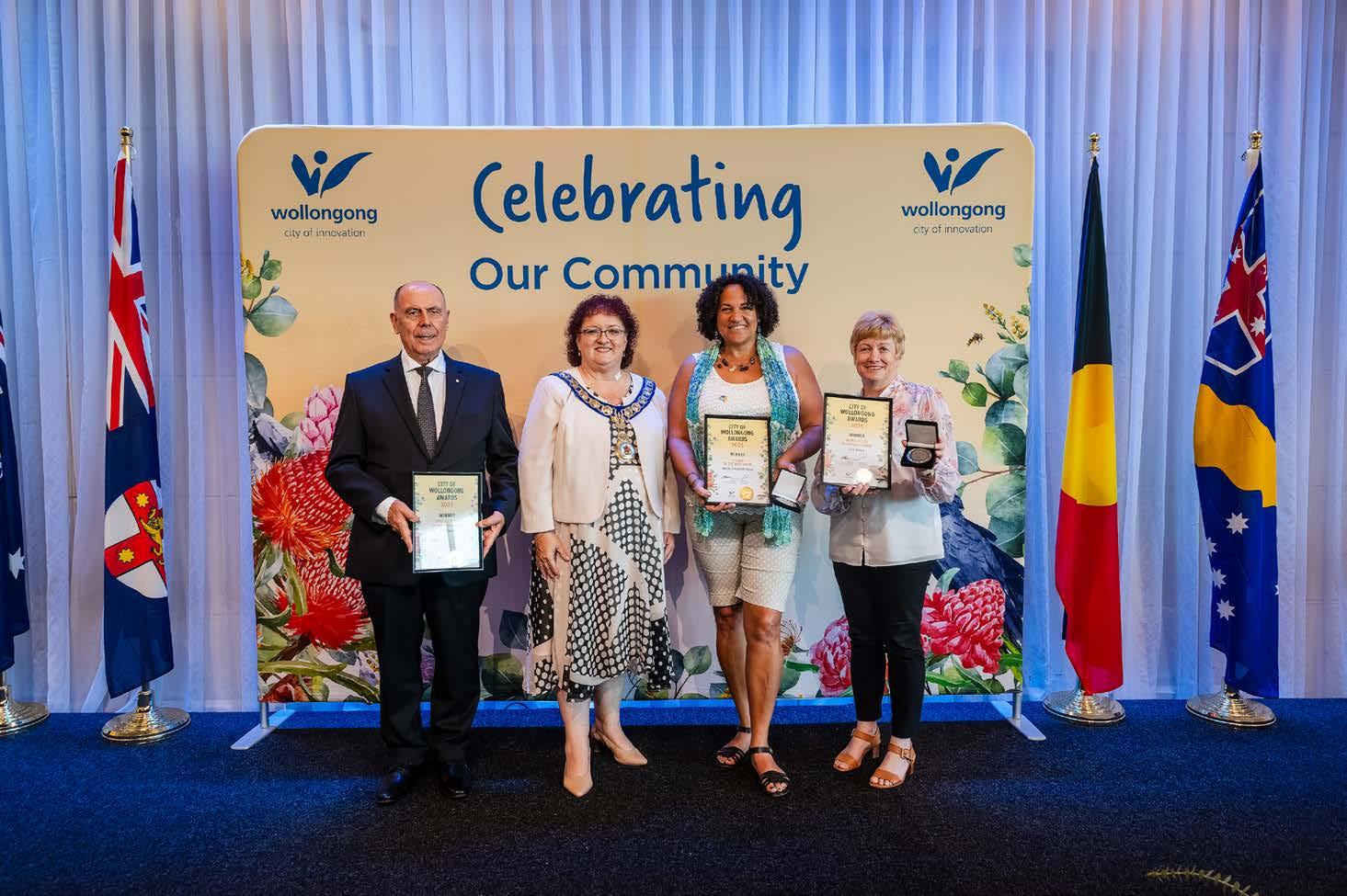
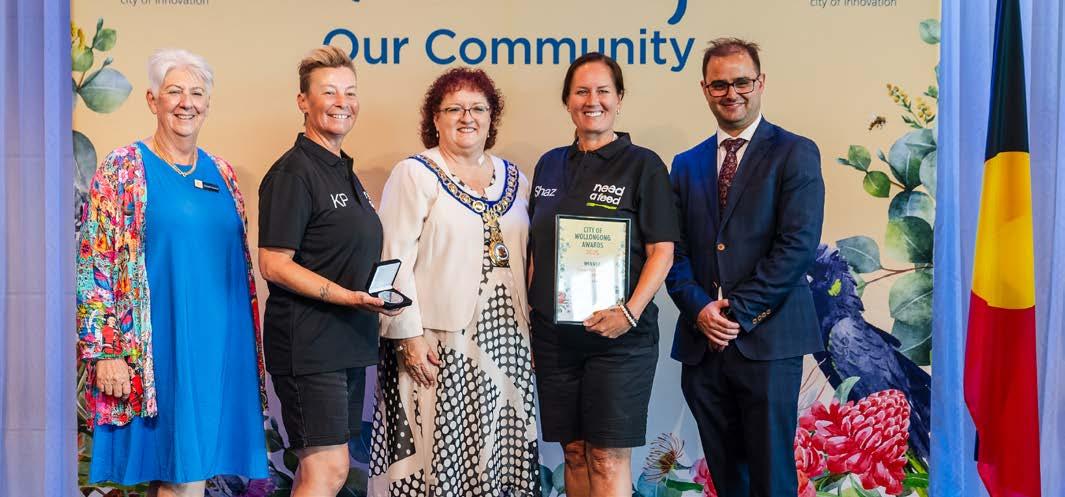

The City of Wollongong’s 2025 Citizen of the Year is Malika Elizabeth Reese, the Young Citizen of the Year is Jack Brown and Senior Citizen of the Year is Ken Habak OAM. Wollongong Lord Mayor Tania Brown described the quality of 2025’s nominations as “outstanding and inspirational”, saying: “The success and vibrancy of Wollongong is built by those who dedicate their skills and time in support of others.”
Read the full report here
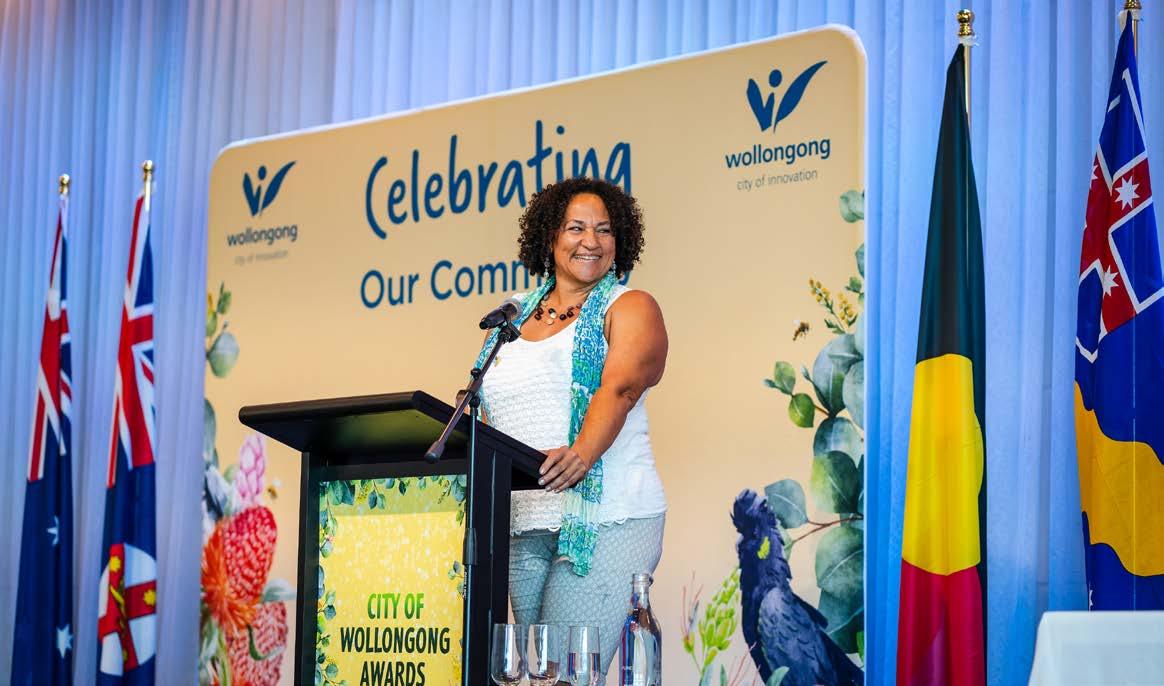
‘I was very lucky to be the only
By Wollongong artist Salwa Woodroffe

“My routine was painting all day in my own studio overlooking the green hills, Orquevaux village and the river.”
– Salwa Woodroffe
Inthe Champagne-Ardenne area of France, the stunning Chateau d’Orquevaux in the village of Orquevaux north-east of Paris offers a residency for visual artists, sculptors, writers, poets, musicians and film directors.
Recently, I was very lucky to be the only Australian selected among 25 other artists from nearly 1500 applicants worldwide.
Chateau d’Orquevaux was built in the 1700s, then renovated later in the style of Napoleon III. The current owner is Ziggy Attias, an American from New York.
An artist, designer, entrepreneur and award-winning filmmaker, Ziggy has made the chateau a beautiful place that inspires creativity. Ziggy collaborated with Beulah Van Rensburg, an Australian artist from Wollongong who owns galleries in Hong Kong, New York and Australia. She is now the cofounder and artistic director for the Artists & Writers Residency programs.
Beulah and Ziggy organise the different daily programs, working directly with the selected artists to share techniques, inspiration and advice on promoting their art.
The chateau is like a palace surrounded by 40 acres of beautiful landscape. The bedrooms are tastefully furnished with floor-to-ceiling windows overlooking the enchanting grounds. The
artists are allocated studios in the chateau, all are spacious with good light.
All meals were provided, delicious and plentiful. There were allocated hours for breakfast, lunch and dinner, all served in the elegant dining room.
My routine was painting all day in my own studio overlooking the green hills, Orquevaux village and the river. In the evening, we all gathered to socialise. This included sharing discussions, enjoying social entertainment (such as karaoke and dance), sitting around the fire in the garden at night, and swimming in the river nearby.
Beulah gave us an informative session on ways of promoting our artwork. This included visits to the studios, discussing individually with the artists their artwork and direction.
The 11th day of the residency was an open studio. Beulah and Ziggy and the other artists visited the different studios to see what each artist had done during their residency. This was followed by a social gathering at the chateau gallery, Galerie Diderot, to view and celebrate the exhibition of our donated art as part of the chateau’s private collection.
I was so fortunate to be offered this chance to immerse myself into art and beauty. The friendships I made will last for a long time. I encourage Australian artists to apply.



Thur
Feb 5
Thur Mar 5
Thur Apr 2
Thur May 7
Thur June 4

Music & Tea | Wollongong Art Gallery | 11am
Entry Free: Donation Appreciated
Ocean Whisperings: Penelope and Other Stories
Olive Cullen mezzo-soprano | Ronan Apcar piano
Clarinet Trios by Beethoven and Brahms
Dan Thomas clarinet | Elizabeth Ring cello
Maria Stadnik piano
Fantasies for Cello and Piano
Shostakovich, Prokofiev and more...
Alexander Boyling cello | TBA Piano
The Chameleon: Clarinet Reflections
Bassi, Mozart, Gershwin, D’Rivera, Weber...
Anna Chung clarinet | Catherine Shin piano
Shades of Romance
Strauss, Wieniawski and more...
Benjamin Lam violin | Dono Ng piano
YOU CAN BOOK ECA SERIES 6 2025 NOW AT
Humanitix: Emerging Concert Artists 2025 Tour
Wollongong Art Gallery | Wombarra | St Jude’s Bowral
For more information, contact Felicity at: e: inspiremusicaust@gmail.com | ph: 0408 422 427

Women are leading local, independent media, Genevieve Swart reports

“We’re seeing women turn off from mainstream news services and largely that’s because they’re not meeting their needs and interests”
– LINA’s executive director, Claire Stuchbery
We call it Cocktail Hour, but in truth most of us are exhausted after the week and sipping tea. It takes a lot of work, long hours and the shape-shifting skills of a chameleon to run an independent media business.
Stella, the owner/editor of Melbourne’s Manningham Life, describes herself as a “one-woman show”. I call it “wearing many hats” and have been switching from one to another since 2013, when we first planted the seed for The Illawarra Flame. Even The Pineapple founder Vivienne Wynter, whose cheerful energy transmits over Zoom from Gympie, admits being a solopreneur is “very demanding”.
The three of us represent a changing of the guard. In Australia, the land that launched the Murdoch empire, all the big media companies are still owned by men. But in small indie media, it’s a different story. Increasingly, publications owned and run by women are gathering under the banner of the Local and Independent News Association (LINA), an industry body founded in 2021.
It’s how Stella, Vivienne and I met.
“We have 91 different publishers in the group and they publish 161 different news services in different parts of the country,” says LINA’s executive director, Claire Stuchbery.
“Of that group, 56% of those newsrooms are led by women, which is unusual in the broader news industry.” There are big gaps to fill – according to the Public Interest Journalism Initiative, 183 Australian news outlets have shut in the past five years and 27 local government areas have no local news. Claire sees independent news as a vital public service, with a healthy media supporting a healthy democracy. Communities want local news produced by local journalists they know and trust, she says.
“A lot of the leaders of newsrooms in the LINA group are very much responding to that need. I don’t necessarily think that that is genderbased, but the reality is that most of our members are led by women.”
Geographically, Stella, Vivienne and I are thousands of kilometres apart. Stella and I are new Australians – she grew up in Malaysia, I’m South African – and we run print-focused companies. Vivienne’s enterprise is a digital-only not-for-profit. But we have something notable in common.
We like our news on the bright side – be it celebrations of community champions or solutions-style journalism.


“We do lots of stories about local residents that have amazing lives and experiences,” says Stella, who has been closely connected to her community through groups such as Rotary for the past 15 years.
“It’s purposeful that I focus on the positive stories,” she says.
“Online, there’s a lot of negativity. I find that I’m providing this little space where people can just say, ‘Oh, I didn’t know this neighbour, who has been in this competition or has won this many things’. They’re inspiring stories, about people who do things that make a difference.
“I just feel good about sharing these stories.
“My master’s is in public policy, so I’ve always been interested in the big picture and making a difference. I guess I’m an unusual editor/publisher in that way, because my perspective is: ‘What is good for the community?’”
Vivienne has a similar take. “Healthy communities are based on citizens informed by facts not misinformation,” she says.
“Having freelanced for News Ltd and Fairfax throughout my career, I’m also motivated by the opportunity to work for my vision of constructive, positive journalism, rather than having to fit into
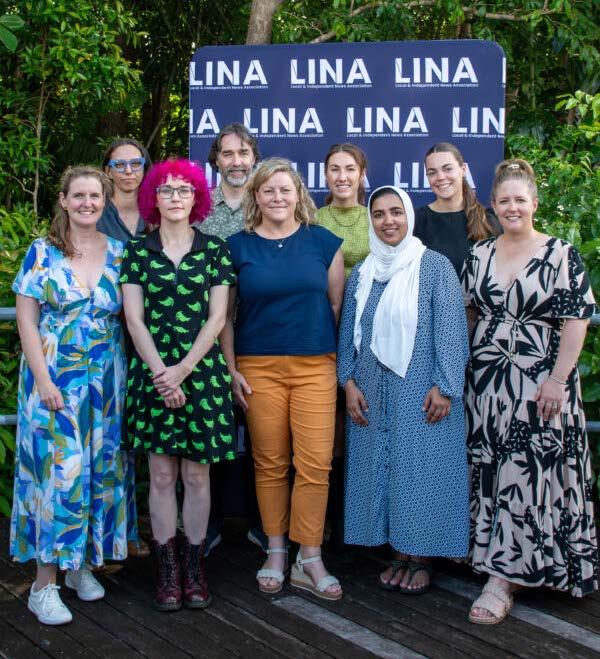
the agenda of the big media organisations who still focus on conflict and bad news.”
Both these approaches mirror the Illawarra Flame’s. And all three of us have loyal, engaged and growing readerships. Could we be the answer to old media’s modern malaise?
‘News Avoidance’ on the rise LINA recognises news avoidance as a growing problem, particularly among women. “We’re seeing women turn off from mainstream news services and largely that’s because they’re not meeting their needs and interests,” Claire says.
“A lot of people, and particularly women, are finding news to be increasingly depressing, and a lot of information that they don’t necessarily feel relates to their lives.”
Both men and women want something the mainstream isn’t delivering, Claire says.
“So they’re starting it themselves.”
While it’s easy to assume young people are both the technology adopters and news avoiders, Claire says they’re just sourcing their news differently – from social media, YouTube in particular. “We’re certainly seeing news avoidance rising on a gender lens, but less so on an age lens.”

